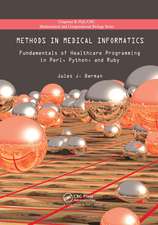Supramolecular Design for Biological Applications
Editat de Nobuhiko Yuien Limba Engleză Hardback – 11 mar 2002
Supramolecular Design for Biological Applications focuses on modulating, altering, and mimicking biological functions with a new family of molecular assemblies. The authors provide innovative ideas and concepts for developing novel biomaterials that could be applied in diagnosis, drug carrier operations, and environmental protection. This reference is comprehensive, presenting principles, applications, recent advances, and future directions. Each chapter includes clear and informative illustrations of molecular architectures. The writing is scientific but allows for easy comprehension of the differences in molecular interactions, dimensions, and supramolecular architecture.
Supramolecular Design for Biological Applications will advance the understanding of supramolecular-structured biomaterials and associated issues regarding biological functions. By explaining recent trends and molecular interactions, this book will enable you to initiate new research for nano-scale science and technology in the 21st century.
Preț: 517.89 lei
Preț vechi: 609.28 lei
-15% Nou
Puncte Express: 777
Preț estimativ în valută:
99.13€ • 107.71$ • 83.32£
99.13€ • 107.71$ • 83.32£
Carte tipărită la comandă
Livrare economică 21 aprilie-05 mai
Preluare comenzi: 021 569.72.76
Specificații
ISBN-13: 9780849309656
ISBN-10: 0849309654
Pagini: 424
Ilustrații: 209 b/w images
Dimensiuni: 156 x 234 x 29 mm
Greutate: 0.94 kg
Ediția:New.
Editura: CRC Press
Colecția CRC Press
ISBN-10: 0849309654
Pagini: 424
Ilustrații: 209 b/w images
Dimensiuni: 156 x 234 x 29 mm
Greutate: 0.94 kg
Ediția:New.
Editura: CRC Press
Colecția CRC Press
Public țintă
ProfessionalCuprins
General Introduction. Basic Strategy for Supermolecular Architectures. Hydrophobic Effects. Hydrogen Bonds. Electrostatic Interaction. Physical Adsorption for Supermolecular Design. Gel and Interpenetrating Polymer Networks. Interlocked Molecules. Biological Application of Supramolecular Architectures. Biodegradable Polymers. Stimuli-Responsive Polymers and Gels. Modulated Drug Delivery. Drug Targeted with Polymeric Micelle Drug Carriers. Gene Delivery. Sensing and Diagnosis. Organic/Inorganic Supramolecular Assembly. Biometric Function. Supramoleculars Surfaces. Supramoleculars Approaches for Cellular Modulation. Future Aspects - Supramolecular Architectures Towards Biological Applications.
Recenzii
"…the contributions have a uniform style and fit together very well. The diligence of the editor is obvious. …all the chapters have very balanced references, citing the important historic contributions to polymer chemistry and networks, and are written in a tutorial style …an excellent introduction to new students seeking to make a career in biomaterials and bioartificial organs, while updating the expert."
- David Hunkeler, AQUA+TECH Specialties, Switzerland, in Polymer News
" … it represents a timely subject, supramolecular assemblies are an exploding area of research with many functional applications. The chapters cover a broad spectrum of topics and include well-respected researchers. I feel that this book would be an excellent addition to the supramolecular literature and a valued resource."
- Allison A. Campbell, Ph.D., Deputy Director, WR Wiley Environmental Molecular Sciences Laboratory, Richland, Washington, USA
- David Hunkeler, AQUA+TECH Specialties, Switzerland, in Polymer News
" … it represents a timely subject, supramolecular assemblies are an exploding area of research with many functional applications. The chapters cover a broad spectrum of topics and include well-respected researchers. I feel that this book would be an excellent addition to the supramolecular literature and a valued resource."
- Allison A. Campbell, Ph.D., Deputy Director, WR Wiley Environmental Molecular Sciences Laboratory, Richland, Washington, USA
Descriere
While the majority of biomedical research efforts to date have centered on utilizing well-known polymeric materials, the recent progress in supramolecular chemistry has introduced a fascinating new field of macromolecular architecture. This book focuses on modulating, altering, and mimicking biological functions with a new family of molecular assemblies. The authors provide innovative ideas and concepts for developing novel biomaterials that could be applied in diagnosis, drug carrier operations, and environmental protection. By explaining recent trends and molecular interactions, this book enables readers to initiate new research for nano-scale science and technology.














